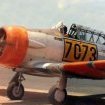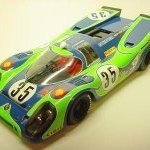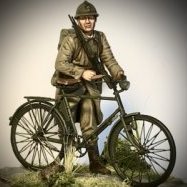-
Posts
13 -
Joined
-
Last visited
Profile Information
-
Gender
Male
-
Location
New Zealand
Recent Profile Visitors
197 profile views
Wirestrike's Achievements

Newbie (1/9)
4
Reputation
-

Angolan T-55 colour and tank commander uniforms colour?
Wirestrike replied to Anthony Kesterton's topic in AFV Cold War
Here you go Anthony, some good footage here showing the colour of vehicles etc. Tanks were no different. -

Angolan T-55 colour and tank commander uniforms colour?
Wirestrike replied to Anthony Kesterton's topic in AFV Cold War
Here is a clip - go to 3min 45secs: -

Angolan T-55 colour and tank commander uniforms colour?
Wirestrike replied to Anthony Kesterton's topic in AFV Cold War
Some pics - green with fading starting to show the yellow and rust coming through. http://travel2unlimited.com/angola-ruined-tanks-on-the-roadsides/ Also a pic of a tank soldier - post SAs withdrawal; however equipment would not have changed once Russia and Cuba withdrew. https://www.gettyimages.co.nz/detail/news-photo/tank-soldier-poses-october-25-1993-in-menogue-angola-news-photo/745554 -

Angolan T-55 colour and tank commander uniforms colour?
Wirestrike replied to Anthony Kesterton's topic in AFV Cold War
It would appear that way Massimo. The one on the left certainly is a T55. If you zoom in (and in my honest opinion) there are shades / remnants of green paint. The rest is yellow and rust. Remember you only need Blue and Yellow to make the colour green so yellow may well be the final colour showing. My personal experience is that all military vehicles in Angola in use by Angolan and Cuban forces were green. The South African forces had various schemes over the years, including an all brown, Koevoet had green vehicles and then the SANDF introduced a three-tone pattern (type in G6 Howitzer or Olifant tank and go to images). I watched a video in which someone asked why the tanks were yellow. The response (by a soldier who was involved in the war) advised they had faded as they were all green at the time of the battle (1987 / 88 period). I will try track down that video. Anyhow, we may have to agree to respectfully disagree on this one. Anthony, from the photos and first-hand experience I have in the theatre, green is the way to go. -

Angolan T-55 colour and tank commander uniforms colour?
Wirestrike replied to Anthony Kesterton's topic in AFV Cold War
Hi Massimo, there were definitely no yellow tanks (or vehicles) used by the Angolans. That is the harsh African climate which has done a magnificent job of weathering. Bear in mind also that these tanks have been lying there since 1987 / 1988. The war ended in 1989 when SA forces withdrew under mutual agreement together with the Angolans, Cubans and Russians aided by the UN. The tanks you're seeing photos of are "recent-ish" photos taken by ex SADF members who have gone on trips to Cuito Cuanavale from Rundu on the Namibian side. This route up to Cuito was the main area of battle for the last year of the war. -

Angolan T-55 colour and tank commander uniforms colour?
Wirestrike replied to Anthony Kesterton's topic in AFV Cold War
There is a captured T34 in Military Museum at Saxonwold in Johannesburg https://ditsong.org.za/museum-of-military-history/. Although it has been stripped and "refurbished", it is overall green - which is what I recall all Angolan forces vehicles being. There are a number of ex SADF members who were involved in the Angolan war who have organised tours and returned to the sites where the heaviest battles took place in the 87/88 period (Ops Modular and Ops Hooper). The video below shows one of the T55s knocked out by the SADF. Clearly green, and also take into account this has been standing "weathering ", fading and rusting since then in harsh sun (+35degrees C, heavy downpours of rain and even sandblasted). The garffiti on the tank would have been done by SA Forces. This period brings back mixed emotions for me but that is another story. I have a friend or two on FB that I could direct specific questions to. As reagrds the uniform, really not sure. I have seen pics of the standard Russian type headgear (let behind in a hurry) but that is all. Good luck, great to see someone doing stuff on this forgotten war (which incidentally went on from 1966 to 1989 - a lot longer than mnost people realise). -
Hi Jo NZ, nope, not yet. I know there is a modelling club in J/ville but have not been out yet. Is that the IPMS one as well or another? If so, please send me a PM re dates and times of meetings etc. Cheers mate.
-
Comment treated with the contempt it deserves.
-
Thanks so much Buz, appreciated. PM sent.
-
Thanks all, it's great to be welcomed so warmly - and have so much in common with fellow members here. Steve and Rob, you're welcome to knock on the door and see what I have wrt SAAF a/c and details when you're ready. Steve, I lived in Nelson for just under 5 years (relocated to Welly in June 2019). Will visit again sometime - when International travel from the North Island to the South island is allowed again :-). Rob, The SAAF did indeed operate Buccs - 24 Sqn - and used them operationally in the SWA/Angolan conflict. The squadron was disbanded in 1991. Some info here for you: https://forum.warthunder.com/index.php?/topic/435181-saaf-blackburn-buccaneer-s-mk50-easy-rider/ as well as here: https://www.saairforce.co.za/ Thunder City in Cape town had Buccs and Lightnings. Sadly they pretty much ceased operations after a bad Lightning crash and related fatality (a Lightning T5, registered ZU-BEX) at an airshow (the official report pointed fingers at the aircraft owners for poor maintenance and failure to maintain safety standards). That being said, to my knowledge the CAA had a part to play as well but that is for talk over a beer. The pilot, Dave Stock, whom I knew very well whilst we were still in the SAAF, was killed. Sad day indeed. Some info here (hard for me to watch): https://www.youtube.com/watch?v=5hLvufAknW8 Cheers.
-
Thanks Dennis the Blabber Mouth :-). From one windy city to another - I am in Windy Wellington. Thank you for the kind words. There is a very good story about a SAAF Shackleton that ditched in the Sahara desert at night whilst en route to the UK from SA in 1994 ( https://samilhistory.com/2016/01/23/the-sad-fate-of-pelican-16/ ). May make for an excellent diorama if you're that way inclined. There is you tube coverage about the story as well ( https://www.youtube.com/watch?v=XCemSU7kAdc - link to Part 1 of 2). As for Mirages, we used F1AZs; F1CZs and Mirage III in the Bush war (South West African / Angolan conflict from 1966 to 1989). I have some decent reference material for those if you wish. F-86s were used by 2 Sqn (The Flying Cheetahs) in Korea alongside your fellow countrymen. It was also the first aircraft type to break the speed of sound on SA soil (I have an article which I obtained from the pilot - John Inglesby - who I spoke to a couple of months before he passed away). So, when you get to building SAAF aircraft give me a shout and I will see what I can dig up for you - or direct you to a source to try get info. Cheers, Adrian
-
Wirestrike started following Greetings from Kiwiland , Kittyhawk IV camouflage, RAAF, 1944, Italy? and Kittyhawks in Italy
-
Hi all, So a bit about me. Rather a diverse background - folks were British, I was born in South Africa and went on to fly fixed wings (including Harvards) and helicopters for the SAAF and SAPS under 2 rather different governments from 1984 - 2001). I now live in New Zealand. My wife and I both had family members killed in WWII (not 100% sure about WWI or the Boer war - although I believe so wrt both of these wars). So, joining to find out more, perhaps ask a question or two and see what info there is to assist with this ever-increasing stash of model kits I have as well as get any info or photos people may have when it comes to family members and specific campaigns. Re my username - not very difficult to guess - I am the survivor of a very serious wirestrike whilst flying a BO105 in the line of duty. Lost my medical but lived to tell the tale. Thanks for having me 😉
-
Hi all, I don't mean to hijack this particular thread started by leyreynolds, but believe it to be the most appropriate one to query about RAF Kittyhawks in Italy in 1945. My query is specific to Kittyhawk IV FX820 (USAF serial number 43-23773), initially operated by 5 Sqn (SAAF), the first recorded Ops sortie being 4/6/44. On this day it was damaged by light caliber flak and damaged again on 22/9/44, this time by 20mm flak. After repair on the second occasion, the aircraft was sent to 250 (RAF) squadron. My query is specific to when the aircraft was at 250 (RAF) Sqn and more specifically on 22/4/1945. The aircraft was being pilot by a family member of my wife (Lt. Bertram Bernard McLeroth, force number: 206907v). He was a SAAF pilot who was seconded to the 250 (RAF) Sqn . On 22/4/'45 he was shot down and killed whilst carrying out a strike on Germans crossing the River Po and heading towards Ferrara. I have not been able to establish the a/c letter (neither 5 Sqn (SAAF) or 250 (RAF) Sqn recorded this in their diaries. What I have found rather confusing is the camo that would have been in use at the time. On another thread (link below) in this forum I found conflicting information which I totally understand - there seems to be very little documented wrt this during this phase of the war. Any assistance would be appreciated. I would like to do a 1/32 scale Kitty as accurately as possible to this era/date and squadron. Also, if anyone has info re the pilot, that would be equally appreciated.






